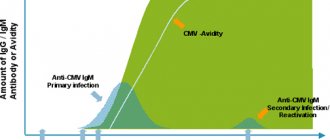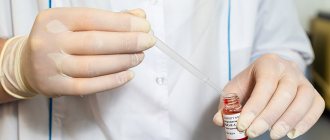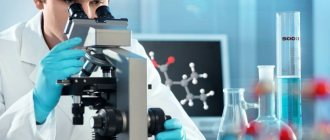What is rheumatoid factor
The name itself, “rheumatoid factor,” is associated with rheumatoid arthritis.
But it is not so. It was discovered while studying rheumatoid phenomena in the joints, hence the name. In fact, the results of the study are a reliable marker for identifying any autoimmune processes. Rheumatoid factor (rheumatoid factor) is specific proteins of the body (autoantibodies) that react with special protective proteins of the immune system - immunoglobulins. It turns out that the body's cells act as enemy agents for its own immune system. If they are produced, the immune system attacks its own proteins, which leads to the destruction of healthy cells. Normally, rheumatic factor is not detected in humans, or its amount does not exceed 14 IU/ml. This tiny amount can only be determined by highly sensitive quantitative analysis.
To determine the rheumatic factor, the following methods are used:
- latex agglutination, also known as latex test;
- Valera-Rose reaction;
- nephelometry;
- linked immunosorbent assay.
Typically, a latex test and enzyme-linked immunosorbent assay (ELISA) are used to identify rheumatic factor.
With the latex test, a rapid determination of the presence of these proteins is done (yes/no).
With enzyme immunoassay, quantitative indicators of rheumatic factor can be determined.
Profile No. 15, Revmotests
Home / For clients / Comprehensive studies / The set of tests included in the package collectively costs 5% - 15% less than each test separately. / Profile No. 15, Rheumatic tests
Article rating: 4.78 (50)
Rheumatic diseases include more than 120 nosological forms of various origins, mainly systemic, less often local, the leading manifestation of which is persistent damage to the musculoskeletal system: joints, muscles, ligaments, tendons and bones.
- rheumatism is an inflammatory disease primarily affecting the heart;
- systemic vasculitis - inflammatory diseases with predominant damage to blood vessels (pulmonary-renal syndrome, aortoarteritis, temporal arteritis, periarteritis nodosa, microscopic polyarteritis, thromboangiitis obliterans, Wegener's granulomatosis, hemorrhagic vasculitis);
- diffuse connective tissue diseases - immunoinflammatory diseases with autoimmune damage to the connective tissue of various body systems (systemic scleroderma, systemic lupus erythematosus, dermatomyositis, Sjogren's disease, Sharpe's syndrome);
- joint diseases - inflammatory diseases with predominant damage to the joints (ankylosing spondylitis, osteoarthritis, osteoporosis, arthritis (reactive, rheumatoid, psoriatic), gout).
The unifying factor for all rheumatological diseases is inflammatory processes and weakened immunity.
Causes of rheumatic diseases.
Unfortunately, medicine cannot yet give a clear answer to the question of the causes of most rheumatic diseases. Theoretical calculations and hypotheses are present in abundance, but most experts believe that the reason for everything is the genotype that the patient inherits from his ancestors. Predisposition to the disease, as well as the influence of provoking factors, leads to an immunological shift, a disorder (the work of one or more existing genes is triggered) as a result of which autoimmune inflammation begins to develop. Provoking factors are: infections and intoxications, nervous shock and hormonal shifts, as well as excessive exposure to ultraviolet rays of the sun (tanning). Manifestations of rheumatological pathologies are typical for patients of any age group, but they mainly occur in mature people aged 45 years and older. So, for example, rheumatic diseases such as osteoporosis, osteoarthritis and polymyalgia rheumatica rarely occur in young people. Although, against the background of traumatic joint injuries and intense physical activity, arthrosis is often observed in young people. This trend is especially pronounced among athletes and extreme sports enthusiasts. Similarly, women of childbearing age who have undergone surgery for diseases of the uterus or ovaries (who have not received replacement therapy after the removal of these organs) are predisposed to osteoporosis due to hormonal imbalance. Some rheumatological diseases may be more common in certain genders. Thus, systemic (autoimmune) diseases, rheumatoid arthritis, vasculitis and polymyalgia rheumatica are mostly female diseases, and psoriatic arthritis, gout and ankylosing spondylitis (ankylosing spondylitis) are more typical for the stronger sex.
Symptoms of rheumatic diseases.
There are a number of signs, the constant presence (for 1-2 weeks) of which urgently requires consultation with a rheumatologist:
- pain in the joints (morning stiffness goes away only after a half-hour warm-up in order to achieve comfortable, pain-free movement);
- stiffness in the back (especially in the lumbosacral region in men);
- increased body temperature observed over several days;
- swelling or swelling in the joint area, changes in their configuration due to changes in bone and cartilage tissue;
- feeling when touched that the joint is warm compared to the surrounding tissues (even hot);
- weakness in the limbs, aching joints, muscle pain;
- nodular formations on the skin from pinkish to purple-bluish;
- recent urogenital or acute intestinal infection, persistent redness of the forehead and cheeks;
- the appearance of areas on the skin with a change in appearance and impaired sensitivity;
- bone fractures, disturbances in their growth;
- the appearance of stretch marks on the skin (if there has been no pregnancy or previous weight loss);
- severe headaches that have a clear localization (especially in combination with weakness, heavy sweating or low-grade fever);
- any combination of the above symptoms or each of them resulting from the listed precipitating factors;
- spontaneous abortions, miscarriage and other obstetric pathologies;
- the appearance of similar symptoms or the presence of rheumatic diseases in blood relatives.
Over the past decades, rheumatology has made great strides forward. Methods of treatment and diagnosis of rheumatic diseases have undergone major changes due to the rapid development of physics, chemistry and biology. Recent advances in rheumatology are closely related to the achievements of immunology, which studies the functioning of the human immune system, since many rheumatic diseases are based on immune malfunctions. Modern immunological diagnostics, which make it possible to detect antibodies corresponding to a specific pathology, are a serious aid in making a diagnosis for a rheumatologist.
The profile includes tests for the diagnosis of rheumatic and autoimmune diseases, and also allows you to identify and evaluate the severity of the inflammatory process.
- SRB
- RF (rheumatoid factor)
- uric acid
- antistreptolysin-O
- antinuclear factor
- IgG antibodies to extractable nuclear antigens (ENA)
- antibodies to cyclic citrullinated peptide (ACCP)
- chlamydia trachomatis (IgG antibodies to heat shock protein HSP 60)
Profile cost:
4811 rub.
Execution time: 1-11 days
Preparing for analysis
Note:
Blood sampling for testing is paid additionally. The cost of taking blood is 110 rubles.
© 2013 - 2021 copyright holder LLC "TIAS LOTUS"
History and philosophy of the company Personal data processing policy For citizens with disabilities Preparation for analyzes Phone numbers of higher-level organizations State guarantee program Payment methods Help for the Federal Tax Service Contacts Our partners
Gemohelp mobile application
8-800-100-08-05
Call if you have any questions
By using the website gemohelp.ru, you agree to the use of cookies
I confirm
More details
Select city:
- Arzamas
- Balakhna
- Bogorodsk
- Bor
- Vacha
- Vyksa
- Dzerzhinsk
- Trans-Volga region
- Kstovo
- Kulebaki
- Lukoyanov
- Lyskovo
- Moore
- Navashino
- Nizhny Novgorod
- Pavlovo
- Sarov
- Semenov
- Sosnovskoe
- Cheboksary
- Chkalovsk
Confirm
When is an RF test prescribed?
The analysis is prescribed in case of suspected autoimmune diseases. Many of these diseases have their own specific manifestations, but often at later stages. At their onset, their diagnosis can be difficult, since the symptoms are usually similar to other chronic inflammatory processes. A rheumatic test allows you to identify autoimmune pathology at an early stage.
It is prescribed to determine:
- rheumatoid arthritis - in case of prolonged inflammatory processes in the joints that are not amenable to standard treatment;
- rheumatism of the heart - pericarditis, rheumatic myocarditis and rheumatic heart defects;
- systemic lupus erythematosus - acute autoimmune damage to various organs (skin, heart, joints, kidneys) and the nervous system;
- systemic vasculitis – lesions of the cardiovascular system of an autoimmune nature;
- kidney damage - rheumatic glomerulonephritis and pyelonephritis;
- lesions of the central nervous system – multiple sclerosis;
- lesions of the pancreas – autoimmune diabetes type 1.
Most often, autoimmune diseases affect several body systems at the same time. For example, with systemic lupus erythematosus, not only the skin is affected, but also the joints and heart (lupus myocarditis). For this reason, the study is prescribed in the presence of inflammatory processes manifested in any organs, or in case of prolonged low-grade fever (body temperature up to 37.5C) and poor health.
Rheumatological complex
Rheumatological diseases in humans are most often associated with joint diseases, although various organs and systems may be affected. How can one suspect a rheumatological disease and what tests need to be taken?
Rheumatological diseases represent a large group of diseases that affect the connective tissue of the body. They are also called autoimmune or systemic diseases. Autoimmune - because the immune system loses the ability to recognize “self or foe” and produces antibodies against its own cells and tissues. Systemic - since connective tissue is contained in all organs and vessels, therefore all body systems are affected to one degree or another. The cause of rheumatological diseases is not completely clear. But the consequences are serious, and early recognition is important for timely treatment and prevention of complications.
How can one suspect a rheumatological disease?
- Severe tiredness, fatigue, general malaise - signs similar to those at the beginning of a cold;
- Muscle and/or joint pain
- Swelling of the joints, changes in the tissue around the joint, up to deformation
- Pain when pressing on a joint or muscle
- Episodes of mild or prolonged fever
- Random detection of elevated ESR in a clinical blood test or C-reactive protein.
The above signs can occur with a number of other diseases, although often they are the only “alarm signals” to start an examination.
In fact, changes often occur in the heart, lungs, kidneys, nervous system and other internal organs, but they do not have clear manifestations. Sometimes you notice signs of skin damage - in the form of various rashes. Redness of the facial skin in the shape of a “butterfly” occurs with systemic lupus erythematosus; thickening of the skin of the fingers with scleroderma.
How is the diagnosis made?
In order to establish a rheumatological disease, the doctor evaluates 2 criteria:
- Manifestations during the collection of complaints, examination and instrumental methods (X-ray, ultrasound, CT). In medical parlance, this is called a “clinical criterion.”
- Laboratory signs
Only on the basis of a joint assessment of clinical and laboratory criteria is it possible to establish a diagnosis of a rheumatological disease and distinguish which disease from the whole group occurs. No criterion is used in isolation!
For your convenience, the main laboratory tests are combined into the “Rheumatological, advanced” complex.
What is included in the complex?
- C-reactive protein is the main indicator of inflammation; in rheumatological diseases it increases significantly, but does not allow us to understand what kind of disease has developed.
- Uric acid increases in the blood and accumulates in the joints during gout.
- Antistreptolysin-O – increases with rheumatism.
- Rheumatoid factor (total antibodies) and Antibodies to cyclic citrullinated peptide are markers of rheumatoid polyarthritis - the most common rheumatological disease, which mainly affects the small joints of the hands with morning stiffness and rapidly developing deformation of the joints when detected late.
- Antineutrophil cytoplasmic antibodies, IgG (ANCA, Combi 6) - are used to diagnose vasculitis. This is an inflammation of small blood vessels, when the kidneys (glomerulonephritis), lungs and upper respiratory tract are mainly affected.
- Antinuclear antibodies, immunoblot - includes the determination of autoantibodies to 14 different antigens. Depending on the identified antigen, the doctor will be able to understand what disease the patient has: systemic lupus erythematosus, scleroderma, Sjogren's syndrome, polymyositis.
- Antibodies to Chlamydia trachomatis, IgG - their determination is important for assessing immunity to chlamydia and excluding Reiter's syndrome. This is an immunological lesion of the urethra, eye tissue and joints, which develops as a result of a long-standing chlamydial infection.
What do you need to take and how to prepare for the study?
To test for rheumatological complex, venous blood is donated in the morning on an empty stomach or 3 hours after a light meal. It is recommended to give up alcohol the day before.
Rheumatological disease is well treated in the early stages. Pay attention to your health, be attentive to yourself and get examined in a timely manner!
How to prepare for research
Basic rules of preparation:
- Blood is donated from a vein in the morning on an empty stomach; before the test you must refrain from eating for 8-12 hours.
- Do not drink any drinks (coffee, tea, etc.). Before the analysis, you can only drink clean water.
- Avoid alcohol and smoking for 24 hours before blood collection;
- Do not eat fatty, spicy, smoked, or other “heavy” foods the day before the test.
- Be sure to inform your doctor about the drugs you are constantly using, as they may affect the test result.
Results of rheumatic factor analysis
Based on the results of the analysis, we can conclude that the rheumatic factor increases:
- slightly increased – from 15 to 50 IU/ml;
- elevated – 50-100 IU/ml;
- significantly increased – above 100 IU/ml.
By the amount of rheumatic factor, the severity of the autoimmune process can be determined.
The analysis is very important, since its result will show the presence and intensity of autoimmune processes and will allow you to quickly select the most effective treatment.







